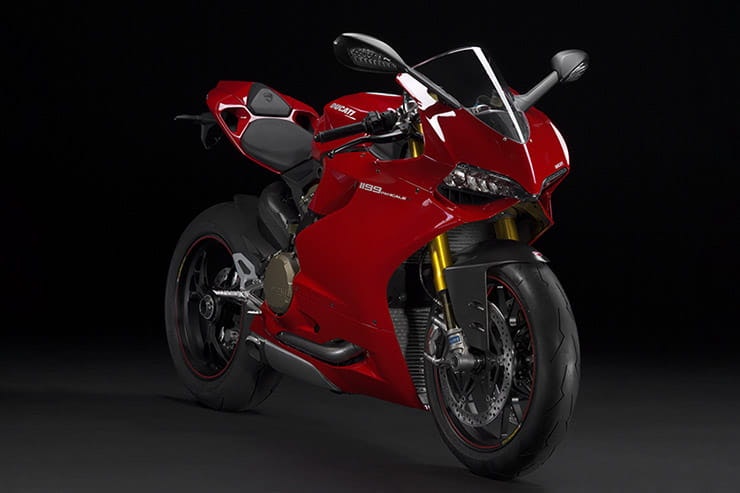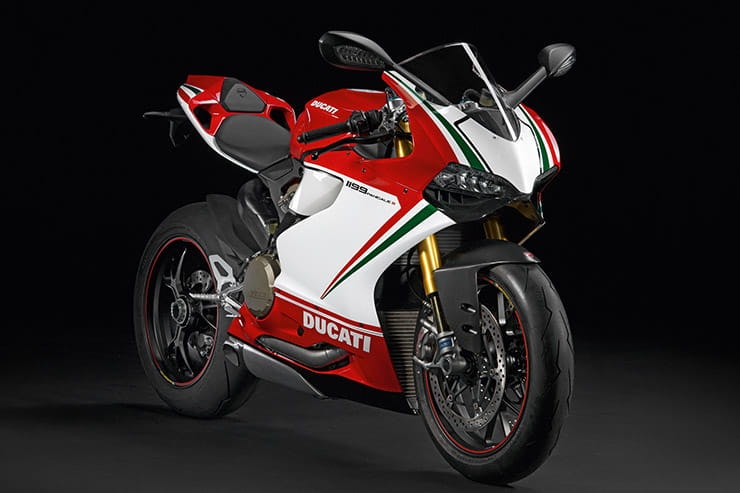Ducati 1199 Panigale & Panigale S (2012-2014) - Review & Buying Guide
By Jon Urry
Massively experienced road tester
09.05.2023
Price: £8000-£15,000 | Power: 195bhp | Weight: 188kg | Overall BikeSocial Rating: 4/5
When Ducati unveiled the Panigale (pronounced Pan-ee-gah-lee by the way, not Pani-gale) they ripped up the rule book. A staggeringly advanced superbike, the Panigale was billed by its Bologna designers as the most extreme benchmark in the superbike class with very good reason. As well as being powered by the most high-tech and powerful V-twin engine on the planet, the Panigale featured a revolutionary monocoque design of chassis and a cutting-edge electronics package that even included electronic suspension adjustment on the S model. Naturally you paid the price for such tech with the S costing over £20k but still, what a bike! Nowadays this first generation of V-twin Panigale is still a remarkable machine that while undeniably a touch harsh and wild to ride has far from mellowed with age. Stunning to look at, mind-bending to ride, the 1199 Panigale is a truly remarkable motorcycle. And one that now used prices have dropped to more sensible levels, is certainly an option for a used superbike buyer. Although ownership isn’t always an easy ride...
Ducati 1199 Panigale and 1199 Panigale S (2012-2014) Price
Buying a range-topping Ducati sportsbike is never a cheap option and back in 2012 the standard Panigale would have set you back £16,250 while the uprated S version was £20,250. The R was a terrifying £26,995 but that’s a whole new kettle of fish...
Nowadays you can pick up a standard model for in the region of £8000 - £9000 for one that is either in a private sale or has gone over 10,000 miles or £10,000 - £11,000 for one with under 10,000 miles on its clocks. Prices for the S version start at £11,000 and rise to the £15,000 area. A Tricolore is also around the £15,000 area. Most Panigales are sold through dealerships however as the bike is now over ten years old, they do crop up in classified ads with increasing regularity. If you want an R, you need to spend at least £16,000 although realistically probably closer to £18,000 for a nice one.
Bonkers engine, good reliability
Amazing looks
It’s a Ducati superbike!
Uncomfortable to ride
Expensive to get major service completed
It’s a bit full-on...
Engine and Performance
The Superquadro engine, so called because it is massively over-square in its bore and stroke, was a ground-up new design for Ducati and as well as being ludicrously powerful is actually remarkably reliable. Despite the fact it puts out a claimed 195bhp (just over 170bhp at the rear wheel) it has 7500-mile service intervals (or yearly, expect a bill of about £250) and only needs its valve clearances checked every 15,000 miles – and there are no cam belts to change, it has cam chains! Ok, the valve-check will cost you in the region of £1000 as it is a nightmare to do but not that many Panigales do a huge number of miles a year. Naturally, when buying used, bear this figure in mind! So what’s it like to ride – absolutely bonkers!
Ferociously powerful, the Superquadro is a hard-revving beast of a motor that is about as far removed from the lovely and lazy Testastretta Evoluzione 1098 or 1199 it replaced as you can get. Where the older V-twin had a bulging midrange, the Panigale tends to feel a bit weaker in this area before going absolutely nuts at the top-end as the power really kicks in. If you are expecting a relaxing V-twin superbike, the Panigale will be quite a shock to your system. There again, this slightly flat bottom end does have its benefits as it means you can ride the Panigale at low revs and it feels quite docile and controllable before teasing (and also scaring...) yourself when you let the motor off its leash and allow it to rev hard! Pleasingly there is no difference in motor between the stock and S model Panigale, so you aren’t missing out on any performance if you get the base bike.
When buying used, aside from the service history, you need to check a few vital areas. The clutch system is prone to letting air into the fluid, which can lead to a grabby feeling clutch and a bike that is reluctant to go into neutral. If it is an issue, an aftermarket slave cylinder with better seals sorts the problem. Internet forums also like to talk about the charcoal canister, which is located on the righthand side just behind the lower radiator. There to please emissions regulations, there is a theory that it can lead to starting issues and a lot of owners remove them. Like so many new models, the Panigale was subject to a few recalls (err, five...) so ensure all have been done by running the VIN plate through Ducati’s service history system via a dealership and be very wary of aftermarket exhausts. Owners report that even the official Ducati Termi system can mark or even melt the lower fairing as the spacer isn’t quite big enough to move it away – and that’s a factory-fit system!
Ducati 1199 Panigale and 1199 Panigale S (2012-2014) Handling & Suspension
Starting with the obvious, the stock Panigale comes with Marzocchi forks and a Sachs shock where the S version has Öhlins front and rear with electronically-controlled damping (DES). Both model’s suspension is fully-adjustable, it’s just that the S’s damping (not preload) can be tweaked via the dash – and no, it’s not semi-active, the system just turns the adjuster for you when you ask it to. So what’s the benefit? There are a few to be fair.
With an S model you can program the suspension’s setting to a riding mode, meaning you can have it softer on bumpy roads and harder on smooth at the touch of a button. Also, the Öhlins shock is fully rebuildable where the Sachs unit isn’t – which matters on a used bike. Add to this the fact the S gets flashy lightweight forged wheels (three spoke where the base model’s are ten) and S models always hold their value better and it is worth trying to save up the extra to buy one if you can. Although if you can’t, it’s not too much of a hardship.
As you would expect on a Ducati sportsbike, the Panigale is staggeringly good when the road is right and a bit of a nightmare when it isn’t. Aim it down a smooth and flowing A-road and it is a joy, incredibly agile with remarkable brakes (ABS is an option) and a feeling of sure-footedness when lent over. Ride it on a bumpy B-road, however, and the front can get lively, the suspension feels harsh (even more so on the stock model without DES) and it is quite quickly very tiresome. Well, what did you expect?
In the used market there is always the usual worry about a seized rear hub adjuster, which should be stripped and regreased at the 15,000-mile service. As Panigale’s tend not to do big miles, this is often a very long time coming so check all is well with the adjuster – jet washing can force water and gunk in there. And be wary of over-tightened pinch bolts, they only need 58Nm of torque, any more can deform the hub.
Comfort & Economy
Comfort? On a Ducati sportsbike? Are you joking? The Panigale is very extreme to ride and as well as the seat being hard, the bars low and the suspension firm, in summer that V-twin motor can get fairly hot... Luckily (for your wrists, no your wallet) the Panigale like to drink fuel and if you average 41mpg you are doing well. The fuel low warning will often come on between 110 and 125 miles and by about 140 miles you will be running on vapours.
Ducati 1199 Panigale and 1199 Panigale S (2012-2014) Equipment
Ok, here is where we need to crack out the acronyms... the 1199 Panigale comes as standard with Ducati Traction Control (DTC), Ducati Quickshifter (DQS), Engine Braking Control (EBC) and riding modes. There are three riding modes – Race, Sport and Wet – and all are linked to the various other systems so that when you change mode the DTC etc also alters. DTC has eight levels (accessed via the switchgear) while EBC has three levels. None of the electronic assists are angle-responsive, IMUs arrived in 2015 on the 1299 Panigale.
The S model adds Ducati Data Analyser (DDA) to the party (an accessory on the stock bike) alongside three-spoke forged wheels and Öhlins suspension with Ducati Electronic Suspension (DES). ABS was an option on both the stock and S model but standard on the Tricolore, which was an S with a red/white/green tricolore (Italian flag) paint scheme, titanium exhaust and DDA+ with GPS lap time function.
When buying used, always check all the features are working and look very hard at the dash for any misting. A lot of owners have found that pressure washing a Panigale forces water into the dash – which is far from ideal. And it’s not just the dash, the switchgear is also known to play up...
When it comes to accessories, Panigales are seldom highly modified. Taller screens and tail tidies are common but that’s about it aside from the occasional bolt-on part such as an engine cover or crash protection. And a loud pipe, a lot have loud pipes...
Ducati 1199 Panigale and 1199 Panigale S (2012-2014) Rivals
The Panigale used to be exclusively for the rich but as prices drop, those who have grown up on a Japanese inline four may be tempted to try it out. That said, most owners have already owned a Ducati before and know what to expect...
BMW S 1000 RR (2012-2014) | Approx Price: £7500-£10,500.
Power/Torque: 193bhp/83lb-ft | Weight: 204kg
KTM 1190 RC8 R (2011-2015) | Approx Price: £7000-£10,000
Power/Torque: 175bhp/94lb-ft | Weight: 184kg
Aprilia RSV4 APRC (2012) | Approx Price: £7500-£9000
Power/Torque: 180bhp/84lb-ft | Weight: 182kg
Ducati 1199 Panigale and 1199 Panigale S (2012-2014) Verdict
When compared to the later 1299 model, the first generation of Panigale feels noticeably rawer and on the edge. Ferocious to the point of being a touch intimidating when you really open it up, the Panigale demands respect and riding it hard is a challenge. That said, its relative lack of mid-range stomp does mean you can take it easy if you want. Bristling with tech, great to look at and a Ducati superbike, there is lots to love about the 1199 Panigale but also a stack of things to be wary of, especially if you are talking a well-used model. Where buying a Japanese bike is a simple choice, you do need to sit and seriously consider if you want to own a Panigale. If you decide to take the plunge it is a remarkable bike and one that always turns heads in a way no Japanese model can, which is all part of the Ducati superbike ownership experience – alongside aching wrists...
Ducati 1199 Panigale and 1199 Panigale S (2012-2014) spec
Looking for motorcycle insurance? Get a quote for this motorbike with Bennetts bike insurance

